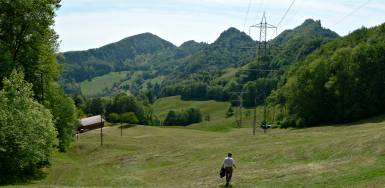Belchenflue Pass
Belchenflue
The Belchenflue, called by the locals Bölchen and to differentiate from the same mountains in Germany and France, also known as Swiss Ballon, is a prominent mountain peak in the Swiss Jura. It is 1099 m high and lies about 7 km to the west of Olten. About the rocky summit, the border between the cantons of Basel-Landschaft and Solothurn.
The Belchenflue is located in a geologically complicated built-up section of the eastern Jura. The Jurassic Period deposited in a tropical shallow sea limestone and marl layers were strongly pressed together during folding of the Jura Mountains in the late Miocene and Pliocene, partially disassembled in shed, slid over one another and made steep. The rocky peak consists of the hard oolitic limestone of the main roe stone, located in the Mid Jurassic ( Dogger ) was deposited. These competent rock layer was dissected out by stronger erosion of the surrounding softer rocks.
It is bordered on the north by the Belchenflue the basin of Eptingen. In the south, several ridges running parallel with intervening valleys and Ausräumungskesseln before the terrain drops steeply to the Swiss Plateau down. The Belchenflue is characterized by a northward incident, up to 80 m high rock wall; and against the south of the mountain drops steeply, but shows only the peak area rocks. Just a few hundred meters west of the Belchenflue is the wooded Ruchen, with the 1123 m above sea level. M. still a bit higher, but far less pronounced than the rock face.
The Belchenflue is part of the Jura main chain between the North West Switzerland and the Central Plateau. It forms the watershed between the Aare River in the south and in the north Ergolz, both left tributaries of the Rhine. To the east the chain over the Challhöchi and Ifleterberg to the pass crossing of the Lower Hauenstein continues. To the west lowers the Dürstelberg to the Upper Hauenstein at Long Bruck.
From Chilchzimmersattel between Eptingen and Langenbruck from the Belchenflue on a road is within easy reach. A varied footpath leads from Allerheiligenberg at Hägendorf to the mountain height. The last section of path to the top is a carved out of the rock staircase, which is secured with railings. The mountain is a popular vantage point with an unobstructed view in all directions except to the west. On clear days you can enjoy a beautiful panorama of the Alps, the Black Forest and the Vosges.
During the First World War, the Belchenflue was an important observation post fortification Hauenstein, a fortress in the Jura system, whose aim was to protect the node Olten. East of the Belchenflue crosses under the A2 motorway the Jura mountains in 3:18 km long tunnel Ballon. Once the summit you can see the highway sections in the north and in the south to near the tunnel portals.
The mountain name comes from the Celtic language and dates back to the sun god Belenus. The Belchenflue is one of the markers of the seasonal Sonnenvisuren in Ballon Triangle and the Ballon d' system whose starting point is the Ballon d'Alsace ( Ballon d' Alsace) in the Vosges. At the time of the winter solstice, the sun is seen from the Ballon d'Alsace from just behind the Belchenflue. Conversely, the sun is seen from the Belchenflue on the day of summer solstice down exactly behind the Ballon d'Alsace.
Gallery
Summit platform
Military road to Belchenflue, built 1914-15










